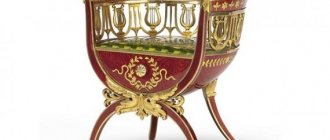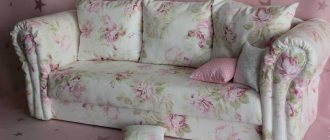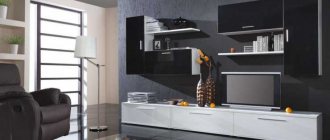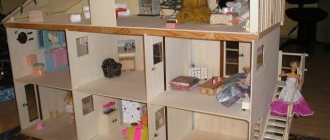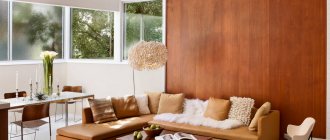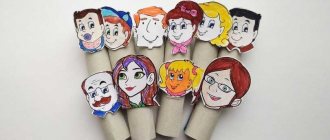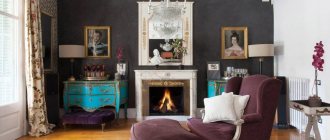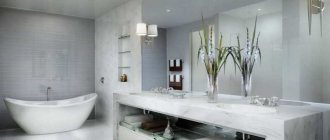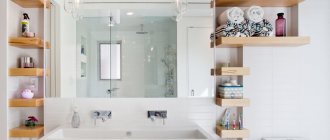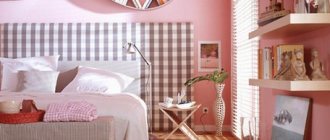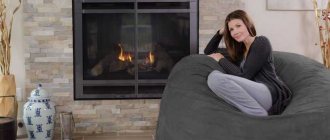Almost every person has moved, made renovations, and as a result they are left with a large amount of thick cardboard. Instead of throwing it away, you should think about the possibility of its practical use.
A table made with your own hands from cardboard can serve as an alternative to traditional types of furniture, and will also allow you to add an original touch to your home. You may doubt the strength of such furniture and the ability to withstand certain loads, but proper processing of cardboard will help here.
This article is intended to help you make a cardboard table with your own hands at home.
Cardboard furniture is a choice for those who care about the environment
Inexpensive, beautiful and environmentally friendly furniture in your home – is it a dream, a fantasy, or is it really a reality? The answer to your wishes is excellent and original cardboard furniture !
You can’t even imagine what a huge amount of different furniture you can make yourself from this material. And you will learn how to turn your dreams into reality from our article. Today, cardboard furniture is very popular in many countries.
Its advantages are quite clear - lightweight, durable, environmentally friendly, inexpensive and, most importantly, it can be easily made with your own hands.
Small coffee table in nautical style
The marine theme is always successful because it is associated with vacation and relaxation - things about which it is impossible to have negative emotions. Such a set will always lift your spirits, especially if you use souvenirs brought from the south to decorate it: shells, stones, sand, etc.
But first you need a base. The material at hand that can be found in any pantry is suitable for it: an old window frame and a wooden handle.
The frame is first cleaned of dust and dirt, the paint is removed, the surface is treated with sandpaper and sanded, and then re-coated with fresh paint of the desired color. If necessary, new glass is inserted into the frame. The role of the base will also be played by the usual available materials: plywood or furniture board.
The cutting is sawn into four equal parts - these will be the table legs. They are carefully cleaned, painted and attached to the base using self-tapping screws.
The table is ready! All that remains is to add decorative details to the empty box, which is a frame: multi-colored sand, pebbles, imitation coral, photos. As an additional decoration, you can use a thick rope that is wrapped around the legs.
Here's another interesting option for a coffee table
The video tag is not supported by your browser. Download the video.
So, you have decided to make a coffee table from cardboard, now you need to understand the technology of its manufacture.
Initially, you should design a tabletop. In order for it to be strong enough to withstand the loads of a monitor or laptop, it is best to design it on two levels.
To do this, using a stationery knife, three elements of cardboard are cut out in a shape reminiscent of the designed tabletop. The first part is the top level, the second and third parts will be used for the bottom level.
Then thin cardboard strips are cut, bent like an accordion and attached with glue to the lower parts of the tabletop. It should be remembered that they are fastened with an edge and the width is of equal size. Therefore, when markings are made, it is better to use a ruler. If, however, the strips turn out to be different in width, this may lead to the appearance of dents. The density of the cardboard strips is also of great importance for the strength of the tabletop.
The next step after laying the cardboard is to attach the second part of the bottom of the tabletop. Next we move on to manufacturing the top level. Strips of cardboard are also glued onto it and after the glue has completely dried, both parts of the tabletop are connected.
To increase the strength of the cardboard strips, it is best to additionally secure them with tape and the corners require special attention.
So, the tabletop is ready, now let's move on to making the base. When making a corner table, you only need two legs. At the same time, to increase functionality, you can also build several shelves.
To make the legs you will need four equal sized pieces of cardboard. Moreover, they can be either rectangular or square. It all depends on the size of the leg. You can also use glue to attach them. It is necessary to make grooves at the junction and secure them with glue.
If you decide to make a solid table leg, then in this case the stiffening ribs can be single-layer, but should be placed quite tightly. It is best to glue strips for shelves and stiffeners 2-3 pieces at a time, which will lead to a more reliable result.
What do you need for work?
The main material for making the table is cardboard. In some cases, you will need sheet cardboard, in others it is enough to take cardboard boxes and scraps.
Corrugated cardboard
Some models of tables are made of paper - plain or newspaper. Also, to make and decorate furniture, you may need additional consumables (pipes, plastic, glass, tape, glue, sandpaper, paint) and simple tools (tape measure, knife, ruler).
Cardboard table - basic option
Boxes from household appliances are perfect for such a product, especially those that are large. To begin with, determine the shape and dimensions of the tabletop: it can be round, rectangular, square.
Advice! In order to be able to place heavy objects on the table (computer, laptop, books), the table top is made of two levels.
Table made of sheet corrugated cardboard
The technology of its manufacture is as follows:
- Using a stationery knife, cut out two identical blanks.
- From the same cardboard, cut many strips about 5 cm wide and bend them like an accordion in any way. All ribbons must be exactly the same in width, so they are first marked on cardboard using a ruler.
- Using glue, securely glue the strips to one of the blanks, placing them edge-on. The tighter they stand, the stronger the finished product will be.
- Allow the glue to dry completely.
- In the second workpiece for the tabletop, holes are made in the corners for the legs.
- The two parts are connected to each other and glued so that the accordions remain inside the tabletop.
- Cut out another strip and paste it over the sides of the future table surface.
- The product can be painted with any paint or decorated with varnish, stickers, ornaments, craft paper, or wrapping paper.
The easiest way to use the legs for such furniture is to use 4 identical pieces of plastic pipe, which are also pre-painted. If the table is corner, you only need 2 legs.
They are glued into the prepared holes and pressed tightly from the inside of the tabletop to its upper part. If desired, a couple of shelves are built at the bottom of the table in the same way, but making them thinner than the tabletop.
Coffee table-pyramid
A cardboard table can also stand on one leg. It will become an original piece of decor, a convenient stand for tea drinking and gatherings with friends. In addition, it will be easy to transport from place to place. The basis for the work is also a large cardboard box from household appliances.
First of all, cut out the pyramid. Its center is a square of any size, with identical triangles extending from each side.
To get the pyramid itself, the triangles are folded inward and all their sides are gradually glued together (using tape and glue). The center of the workpiece remains at the base of the pyramid - a square.
Gluing the pyramid
The table surface is made from a large cardboard box lid or glued together yourself. The edges of the tabletop must have sufficient thickness (at least 5-6 cm).
Important! To strengthen it, a frame in the form of a lattice of light wooden slats is glued inside, otherwise the table may bend under the weight of heavy objects.
Next, the table is finally assembled: the sharp end of the pyramid is inserted into the center of the tabletop, carefully cutting a hole at the top. Glue all the grooves and let the glue dry for 24 hours. Furniture is decorated randomly. For example, they are finished with foil, kraft paper, self-adhesive film or covered with acrylic paint.
Cardboard coffee table
Table made of paper stones and glass
The surface of such a product is made from a finished piece of glass or plastic, and it can have any shape and size. The table leg is unique - it is made of paper stones, which are made from corrugated cardboard.
Flat cardboard is not suitable for this purpose, nor is material with various inscriptions and drawings. The ideal option is to use unnecessary boxes or ready-made sheets of corrugated cardboard.
Table on stones made of cardboard
Furniture legs do this:
- Remove all stickers and tape from the boxes.
- The raw material is torn into pieces, then crushed into fine crumbs in any convenient way.
- The paper crumbs are poured with water in a large container, left for 1-2 days, and the mass is stirred periodically.
- After complete liquefaction, carefully squeeze the water out of the cardboard.
- In another bowl, dilute the PVA glue with a small amount of water so that it becomes a little thinner.
- Add cardboard pulp to the glue and knead the “dough”.
- Stones, columns or other products that could serve as legs for a table are fashioned from the mass.
If the stones are large in size, to save cardboard mass, the inside of each product is stuffed with crumpled cardboard, which was previously wrapped with masking tape. This lump is coated with gruel, compacted and given the desired shape.
The cardboard mixture is applied in layers, with the layer thickness being about 1 cm. After drying, a new layer is applied.
Dry stones only in a dry room, otherwise they may crack. After 14 days, they are sanded smooth with sandpaper or a sander so that the top is flat.
Making cardboard stones
Then the workpieces are coated with wood primer. A finished tabletop made of tempered glass or other material is glued to the top of the stones.
Table made of cardboard boards
Such a table will be incredibly durable, beautiful, and at the same time very cheap. The base material (cardboard boards) is also suitable for making chairs, shelves, racks and other furniture. To work, you will need identical sheets of corrugated cardboard of the required size.
These sheets are glued together with any of the following compositions:
- Wheat paste. Heat 1 part flour and 4 parts water over low heat until a thick mass is obtained. A little bactericidal primer is added to the finished product.
- Glue on wood. This composition can be purchased at any hardware store and diluted 1:1 with water.
- Wallpaper glue. It is also diluted with water according to the instructions.
Place the first piece of cardboard on a flat surface, apply a large amount of glue, and distribute it evenly. Continue to place cardboard and fill it with glue, gradually reducing the consumption of the product.
The finished board is laid to dry in the sun for 2 hours, or indoors for a day. After drying, the blanks are used to form a table top and other table parts, and decorate the product in any convenient way.
Cardboard is a universal and multifunctional material. If you use your imagination, you can make a lot of useful and practical things out of it without spending extra time and money.
DIY coffee table.
You decided to buy a high-quality and inexpensive coffee table, but after shopping, you were probably convinced that high-quality coffee tables made of natural wood cost good money.
There is a solution - to make a coffee table with your own hands. If we knew how to make a magic wand, then everything would be much simpler, but we will have to work a little and you will see that there is nothing complicated.
In this material we will look at making a coffee table from natural wood with our own hands, as they say from “A” to “Z”.
Of course, you still can’t do without financial investments, but they will be several times less than the cost of a coffee table bought in a store.
Coffee table shown in the photo. 1 cost approximately 1000 rubles.
And two days off for the time spent on making the table (including painting and drying).
Photo. 1 DIY coffee table. Prepared for final processing - staining and varnishing.
Table dimensions table top 1000 mm x 600 mm thickness 30 mm shelf (size is selected after attaching the legs) of this table 640 mm x 430 mm, thickness 18 mm.
The height of the coffee table from the floor is 450 mm.
The most difficult part of the table is the tabletop and shelf. We will have to buy them (fortunately, the stores have everything), since, without special equipment and devices, making a high-quality product is quite problematic.
The tools you will need are a jigsaw, a screwdriver or drill, PVA glue or any other glue designed for gluing wood.
The entire process of assembling and making a coffee table with your own hands is shown in detail in the photographs.
Making the legs of a coffee table (photo 2).
Photo. 2 Making coffee table legs.
The legs are cut with a jigsaw from a block of at least 150 mm wide, 430 mm high and 45 mm thick and carefully processed with sandpaper.
For those who are interested in this coffee table design, the stencil form of the legs can be downloaded HERE.
Unfortunately, the height of the table legs is larger than the size of a standard A4 sheet, so the stencil form consists of two halves. Print both and glue them on thicker paper or cardboard. All that remains is to transfer the stencil shape of the legs of the coffee table onto the wood and cut it out with a jigsaw.
We attach the legs to the tabletop (photos 3, 4, 5, 6, 7, 8).
Naturally, we start by marking the place where the legs of the coffee table are attached (see photo 3).
Photo. 3 Marking the location of the coffee table.
We fasten the legs to the table top in a “tenon” using wooden “caps”, and put them on glue (PVA or any other intended for gluing wood), you can additionally strengthen the connection with a metal corner on a self-tapping screw (see photos 4, 5, 6).
Photo. 4 Attaching the legs of a coffee table.
Photo 5. Attaching the legs of a coffee table.
Photo 6. Attaching the legs of a coffee table.
Rice. 7 Attaching the legs of a coffee table.
Rice. 8 Attaching the legs of a coffee table.
Fastening the shelf of a coffee table (photo 9).
Photo. 9 Attaching the shelf to the legs of the coffee table.
We fasten the shelf with self-tapping screws (see photo 9). One caveat - before tightening the self-tapping screw, it is better to pre-drill a hole with a drill of a smaller diameter (to prevent cracking of the wood), otherwise you can ruin the whole job.
The coffee table is ready, and moreover, made with your own hands from natural wood. All that remains is to cover it with stain and varnish. The color depends only on your preferences.
Cardboard table
Browse products for inventors. Link to the store.
I needed a new coffee table. After laying out all the packing boxes, I thought, why don't I use these cardboards to make a table? For the table legs, I decided to use a cardboard tube.
Step 1: Design
DIY electronics in a Chinese store.
At first I wanted to build a table from scratch - using cardboard sheets. Then I realized that I have one large cardboard box that I use to store my things. It will be easier to modify this field to become a tabletop than to create one from scratch. However, I didn't want to lose my coffee table storage box, so I decided to combine both - storage box + coffee table. The idea is to reduce the height of the box, add a cardboard tube as a support, and use the top lid of the box as a table top. The table top can be opened to access table storage.
Step 2: Gather your tools and materials
Corrugated cardboard box - preferably a half slotted container (HSC) because the open top lid can be converted into a table top. Corrugated cardboard sheets.
Cardboard Corner - I don't know what this thing is actually called, it's an L shaped cardboard that comes in a cardboard box to protect the edges. Cardboard tubes – 4 pcs. White PVA glue. Screws are of different sizes. Screwdriver. Stapler. Hand saw. Craft sticks - a lot. Cutter. Round refrigerator magnets – 4 pcs. Dye. Wallpaper, sticker type – 1 roll (5 mtr).
Step 3: Create a Support Beam
My cardboard box is too tall for the coffee table. Therefore, first it needs to be cut so that the final height is only 400 - 450 mm. Next, you need to create a support beam to accommodate the tabletop. This is done by cutting the top corner of the box and bending it into a rectangular beam shape. Use glue and a screw to secure the folded beam to the box. Do this on all four corners.
Step 4: Construct a Guide
The tabletop will be pushed apart on top of the support beam. To do this, use a cardboard corner as a guide. The lower part of the guide is cut to 20 mm in length. Simply add a 20mm thick strip of cardboard to the inside of the cardboard box. This will act as a guide. Next, you need to cut an L shape on the side of the box so that the cardboard corner can slide out.
Step 5: Build the Table Legs
Take a cardboard tube and remove ¼ of the circle as shown in the picture above. I use a handsaw (poor man's method) and a cutter to cut the tubing. Leave 25mm of the bottom of the tube to become the bottom support. Glue + screw tubes to each edge of the box. You now have a tabletop box with a 25mm gap from the floor.
Step 6: Build the Tabletop
Believe it or not, I spent more time making the table top than the other parts. First, cut the top lid of the box into equal halves. Make a cuboid out of the lid with the following dimensions: length 40 mm, width 39 mm and thickness 25 mm. Attach the side guides to the bottom of the cuboid. Stuff cardboard strips inside to reinforce the tabletop. The challenge is ensuring that the two tabletops are perfectly aligned with each other and at the same time can slide smoothly across the table. I add a "hole" on both ends to help open/close the sliding tops. I also add refrigerator magnets to the joining edge to secure the countertop when joined together.
Step 7: Plaster and Paint
Use putty to fill any holes, gaps and uneven surfaces before painting. At this point I add a "frame" to the table using a mounting board. Ideally the surface should be flat and clean for the next step. Paint everything except the countertop surface.
Step 8: Add Wallpaper
It might feel weird to cover a box/table with wallpaper, but I think it's the easiest way to decorate a plain + boring table. I use sticker-type wallpaper, which is very convenient to work with. Simply measure the length of the side, cut the wallpaper and stick it. As you can see, there are bubbles in some areas of the wallpaper due to the roughness of the surface. Therefore, it is important to properly prepare the surface before applying wallpaper.
Step 9: Finishing the Countertop
I wanted to do something different for the tabletop, so I decided to cover it with craft sticks - yes, craft sticks. Use a knife to cut the sticks to variable lengths and glue them on top of the cardboard. I ended up using about 250 sticks. It's a tiring job, but it's fun at the same time. Placing the sticks into pieces is like completing a huge puzzle. And finally, I have a new coffee table - I wouldn't say it's the nicest coffee table, but I now have a table + storage. Two in one!
Necessary tools and material
In the process of manufacturing cardboard furniture, the main role is played by the main raw material (cardboard) and related materials to create the final product. Regardless of the type and purpose of the creation being invented, the list of tools will remain unchanged:
- a stationery or construction knife with a sharpened edge;
- ordinary or paper tape, double-sided;
- scissors;
- roulette;
- ruler;
- pencil and grater;
- sandpaper for sanding cuts;
- PVA glue, Moment, hot melt glue or construction glue (selected depending on the type of cardboard used);
- kraft paper.
In addition to these positions, it is worth thinking about the decor of future furniture. Fabrics, paper, wallpaper, paints for creating unusual designs, etc. are suitable for this.
As for the choice of the main material - cardboard, you need to take into account the strength parameters that will extend the service life. Furniture made from corrugated cardboard should be preferred because old boxes may not be durable. The more sheets there are in such cardboard, the stronger it will be in the future. The number of layers of paper and cardboard varies from 2 to 7.
Advantages of a cardboard table
Before you start making furniture from cardboard, you should initially consider its main advantages, which include:
- stylish and original design. Cardboard will allow you to design and make almost any piece of furniture based on your own taste;
- efficiency. During production there is no need to purchase consumables and pay for delivery and installation. It is necessary to invest only in the necessary tools, which can then be used in the manufacture of other pieces of furniture;
- mobility. Furniture made of cardboard is easy to unfold, which makes it convenient for transportation;
- ergonomics. Cardboard furniture saves you time by eliminating shopping trips, is comfortable and is designed to suit your personal taste;
- safety. Environmentally friendly material will be safe for you throughout its entire service life;
- strength. If you approach the process of manufacturing and processing the material itself (cardboard) correctly, the resulting result will please you for a long period of time.
But as they say, in every barrel of honey there is a fly in the ointment. The main disadvantage of cardboard furniture is that it is negatively affected by humidity and this type of furniture cannot be used outdoors in damp or rainy weather.
How to make it yourself
As with any assembly, the master must have a standard supply of tools. Below we will consider the main nuances of making furniture from cardboard. Proper preparation is the key to success.
Cardboard is an environmentally friendly product and does not have a negative impact on human health.
Required materials and tools
The thicker the cardboard, the stronger the product will be. Equipment is often packaged in such material or heavy products in the form of canned food, etc. are transported in it. Therefore, it is worth looking in warehouses, stores and other facilities.
Cardboard varies in density and characteristics. Each type of material has its own purpose.
As for tools and additional items:
- How to understand whether cardboard is thick or not - light is always thinner. The darker the consumable, the denser it will be.
- Scotch tape, glue - using glue will be stronger, but tape will be needed for temporary fixation. What kind of glue - PVA, any construction glue, the main thing is that it is transparent, so it will be easier to hide imperfections and joints.
- Craft paper - used for fixing joints.
- Tracing paper is white paper, ideal for decoration or as a base.
- Wallpaper, fabric, self-adhesive - all this can be used for decoration.
- Pencil, tape measure.
- Knife – preferably a stationery knife.
- Sandpaper.
- Construction hairdryer - if glue will be used.
Designer cardboard can be of different shapes, sizes, and colors.
As practice has shown, in a home storage room, all this can be found without problems. You can make furniture from cardboard or store boxes yourself even with children.
Drawings and diagrams
The preparation process includes not only collecting everything necessary, but also cleaning the main material. The cardboard that citizens buy in stores or warehouses contains a huge amount of tape and glue. Many modules can be stored in damp conditions for months, so the selection of material must be done with particular care.
The process of preparing for work includes not only the selection of material, its cleaning and disassembly, but also the creation of drawings.
Once the cardboard has been cleaned and prepared, you can begin searching for the instructions you need. Below are the main options that you can use for home creativity.
First of all, you need to decide on the type of furniture and model. Then choose the most successful scheme.
Important! If you independently search for cardboard products online, you may come across counterfeits for dollhouses. To prevent this from happening, it is better to search on specialized sites and forums.
Forming parts
As long practice has shown, the formation of parts from which furniture is assembled occurs according to one system. First, paper patterns are made, then they are applied to the base, and then fastened together. Before assembly, the joints are treated with sandpaper. After this, the protruding corrugation is covered with tape, after which it is treated with glue and dried under a hairdryer.
At least three-ball raw materials should be selected. If this is not available, you can glue together several sheets of thin cardboard, which will increase its strength.
By the way! To make the cut and joint areas look attractive, you can seal them with furniture putty.
If a craftsman plans to make the most durable product possible by gluing together several layers, they need to be placed under a press. Then the plates will be neatly connected, and excess glue can be collected with a rag or sponge.
If necessary, stiffeners can be used to strengthen the structure.
Fastening the structure
Strengthening the structure is a rather complex process. If children's play furniture can do without this, then the crib and shelving will definitely have to be strengthened. The first thing that can be useful in home engineering is stiffeners. How to make them correctly can be found in the design diagrams above.
The finished product can be protected from moisture and its strength increased by applying parquet varnish to the surface
What other techniques may be needed:
- Parquet varnish – protects against high humidity.
- Symmetrical furniture - in this case, the very design feature gives stability. You can experiment with shapes, but then you will have to come up with options for strengthening yourself.
- Two-layer parts - everything should be clear here, the thicker the walls, the stronger the module.
Using the above recommendations, there will definitely be no problems with strength.
Grooves and stiffeners must be coated with glue, thereby extending the service life of the structure.
Assembly technology
For convenience, experts have identified several interesting methods that will be needed when assembling cardboard furniture.
For example:
- Layer-by-layer bonding of plates is a technology invented by Frank Gehry in 1970. By the way, several items from the collection are still bought in Europe, the average price is $400. The system is simple - a figure is invented, after which the parts are cut out according to the pattern, then the contours are connected. Examples of finished products can be found in the photo.
- Frame furniture is made from a large number of stiffening ribs. In fact, this technology looks like a structure made of many accordions.
- Frame furniture covered with paper is ideal for creating unusual shapes. First, the main frame is made from the ribs, after which the decorated part is assembled according to the pattern.
- Origami is one of the interesting methods that is distinguished by its creativity. By the way, the furniture turns out to be quite stable. The main thing is to find the right scheme and have good physical fitness.
Possible options can be used individually or combined.
The last method is to use phases or modules. Assembly is only suitable for professionals, because each part must be as smooth and accurate as possible.
